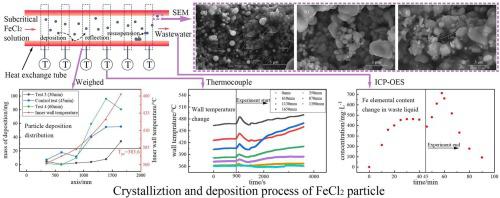Powder Technology ( IF 4.5 ) Pub Date : 2023-11-27 , DOI: 10.1016/j.powtec.2023.119198
Zilun Zeng , Yuhang Li , Hongyuan Li , Chao Wang , Naiqiang Zhang , Hong Xu

|
Particle deposition poses a significant challenge to the economics and safety of supercritical boilers. Understanding the deposition behavior of particles on the steam-water side wall is essential. A supercritical particle deposition system was designed and build according to the actual conditions. The effects of fluid thermal state, flow rate and exposure time on particle morphology, deposition layer morphology and deposition distribution were investigated. The results showed that FeCl2 was oxidized to micron sized Fe3O4 particle, and the salt crystals had a redissolution behavior in supercritical water. The particle deposition layer was a three-layer structure, possibly related to the gas-like fluid clusters and turbulence. The deposition distribution was related to the flow state, and there was a forward shift of the peak point with exposure time. Our results help to understand the particle deposition behavior in supercritical heat exchangers.
中文翻译:

Fe3O4在超临界换热管内颗粒沉积的实验研究
颗粒沉积对超临界锅炉的经济性和安全性提出了重大挑战。了解颗粒在汽水侧壁上的沉积行为至关重要。根据实际情况设计并搭建了超临界粒子沉积系统。研究了流体热状态、流量和暴露时间对颗粒形貌、沉积层形貌和沉积分布的影响。结果表明,FeCl 2被氧化成微米级的Fe 3 O 4颗粒,且盐晶体在超临界水中具有再溶解行为。颗粒沉积层为三层结构,可能与类气流体团簇和湍流有关。沉积分布与流动状态有关,随着曝光时间的延长,峰值点出现前移。我们的结果有助于了解超临界热交换器中的颗粒沉积行为。

































 京公网安备 11010802027423号
京公网安备 11010802027423号